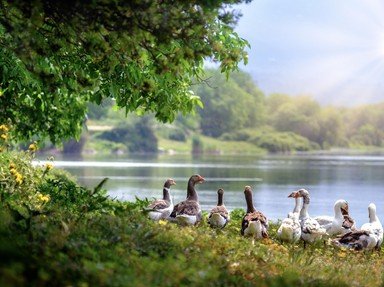Quiz Answer Key and Fun Facts
1. "Dear Santa,
I would like to apply for a job helping with the transportation of your sleigh this year. In support of my application I simply wish to supply a single statistic: on average I travel over 70,000 kilometres (44,000 miles) a year. The requirements of your customers on Christmas Eve would simply provide me with a little light exercise.
Yours confidently,
Sterna paradisaea"
Which of these is the pictured bird that takes an annual trip from the North Pole to the South Pole and back again?
2. "Dear Father Christmas,
I believe that I would be an ideal candidate for a position pulling your sleigh. I am renowned for my ability to fly silently and (if you were to consider removing the "jingle bells" from your vehicle) could significantly decrease the number of complaints you must receive from the parents of young children woken up by your arrival at their chimney.
Yours sincerely,
Bubo scandiacus"
By what common name is the Arctic bird Bubo scandiacus better known?
3. "Dear Mr. Claus,
Please give strong consideration to my application for the post of 'sleigh puller'. A temporary job working for you over the Christmas period may just save my life, as thousands of my close relatives are lost to Christmas dinner plates every year.
Yours desperately,
Chen caerulescens"
Which of these is the pictured member of a family of birds that includes species traditionally served up for Christmas dinner?
4. "Dear Sir,
Although my photograph may not give the impression that I would be a good candidate for soaring through the sky on Christmas Eve, I am accustomed to working at great heights as I live high up in the mountains. I also have excellent skills in the area of camouflage, so it is likely that nobody would notice the loss of your reindeer if I were given the job of replacing them.
Yours confidentially,
Lagopus muta"
Which Arctic gamebird wrote a letter to Santa enclosing this self-portrait?
5. "Dear Saint Nicholas,
I would like to offer my services to convey your sleigh around the world on the eve of Christmas. I believe I would add a much-needed aura of royalty, elegance and sophistication to your worthy journey.
Yours regally,
'The King'"
'The King' enclosed a signed photograph with his letter of application. To which species of sea duck does this particularly colourful character belong?
6. "Dear Mr. Kringle,
I'm aware that you were particularly fond of one of your previous employees because of his "nose so bright" that "you would even say it glows". I am in possession of a particularly colourful beak and feel thoroughly confident in my ability to act as a fog lamp and guide your sleigh on Christmas Eve if the need arises.
Yours brightly,
Fratercula arctica"
This particular applicant has failed to remember that in his winter plumage (which he will clearly be wearing at the time the job starts) his bill is considerably less bright. What is the common name of this bird?
7. "Dear Santa Claus,
I realise you must be wading through many applications for your post of reindeer-replacement, but I would like you to consider me for the job. I would be prepared to undertake an early relocation to the Arctic this year in order to facilitate the delivery of the world's Christmas presents (and show you the locations of some nice sandy beaches once the festive season is over).
Yours deferentially,
Calidris alba"
Many of the world's wading birds make their home in the Arctic - which one goes by the Latin name Calidris alba?
8. "Dear Mr. Christmas,
I am writing this letter of application to you following a considerable period of reflection on my suitability for the job. I was a little concerned that you had previously hired reindeer known as "Prancer" and "Dancer" as I have some difficulty with simply walking. However, when I heard about "Cupid" I became more confident that I was the right bird for the job, as my monogamous devotion to my partner has been noted in several ornithological texts.
Yours hopefully,
Fulmarus glacialis"
To which species does the author of this letter belong?
9. "Hi Santa!
We have put our wings together, figured out how to hold a pen and are writing to offer to pull your sleigh this year. We're quite small - see enclosed photograph - so we think you'll definitely need all four of us. The colony we live in is really big though, so if you do need more staff we can just ask some more of our friends to help as well.
Yours collectively,
Alle alle(s)"
By what name are these members of the Alle alle species better known?
10. "Seasons tweetings Santa,
Since I live so close to your headquarters, I thought I'd better write and offer to pull your sleigh this Christmas despite my diminutive size. I am a regular long distance flier and since I usually spend the winter feasting on seeds, I'm pretty certain that I could adapt to a diet of donated carrots.
Yours neighbourly,
Calcarius lapponicus"
Which of these Arctic birds was responsible for this final missive?
Source: Author
Fifiona81
This quiz was reviewed by FunTrivia editor
rossian before going online.
Any errors found in FunTrivia content are routinely corrected through our feedback system.

